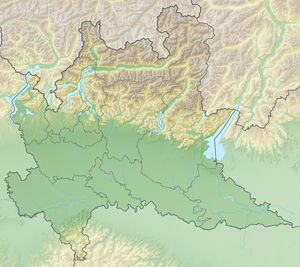Castello Santa Maria Tirano
| Castello Santa Maria | ||
|---|---|---|
| Alternative name (s): | Castellaccio | |
| Creation time : | 1492-1493 | |
| Castle type : | Höhenburg, hillside location | |
| Conservation status: | Partly restored ruins | |
| Place: | Tirano | |
| Geographical location | 46 ° 12 '40 " N , 10 ° 10' 27" E | |
| Height: | 480 m slm | |
|
|
||
The Castello Santa Maria in Tirano , coll. Also Castellaccio called, is partially restored ruin a hillside castle to 480 m slm , which together with the fortification 1492/1493 by the Duchy Milan was constructed ( Ludovico Maria Sforza , 1494 to 1499 and 1500 Duke of Milan) and partly still exists today.
Surname
The Castello Santa Maria was named after a nearby, long since abandoned chapel dedicated to Mary.
history
Tirano has always been at a crossroads between the north-south connection from the Rhine Valley to the Po Valley and South Tyrol and the area around Lake Como . In the 11th century the Dosso castle already existed in the nearby district of Dosso and Triano developed on the left bank of the Adda river below the castle. This Dosso castle was probably destroyed by the Grisons in 1487.
On behalf of Ludovico Sforza (called il Moro ), the Italian-Swiss sculptor , architect and engineer Giovanni Antonio Amadeo (1447–1522) planned the city fortifications and the castello as part of this city fortification (curtain wall ) from around 1487 and then built them. The city wall was opened through the three gates still preserved today, Porta Poschiavina towards Bernina, Porta Milanese and Porta Bormina and through the access via the Castello. This city fortification was largely destroyed again in 1512 when it was occupied by the Grisons.
The ramparts of the city fortifications, the Castello, were quickly repaired or rebuilt during the time of the Veltliner Murder ( Italian : Sacro Macello ) and used by the Spaniards to defend the city, which was conquered by the Swiss troops in the battle of September 11, 1620. From 1627 it was decided to dismantle all existing fortifications.
The ruins were partially restored in 1938–1940 and in 2000, further renovations are ongoing.
Location and strategic function of the Castello
The surrounding valleys of Chiavenna , Valtellina and Bormio have been of strategic importance since ancient times, as they are crossed by numerous traffic connections between the Po Valley and the northern side of the Alps. Two important geographical and political axes intersected in these areas: Vienna - Milan ( Habsburg / Spain ) and Paris - Venice - Rome ( France / Venice / Vatican state ), which were repeatedly controversial and sought after.
The Castello is about seven minutes 'walk from Porta Milanese and about ten minutes' walk from the historic old town . The function of the castle complex was to maintain an overview of the place, the valleys and the city fortifications from the mountain side.
Construction of the Castello
The castle complex consists of a four-storey square tower with a gable roof in the center. This tower is enclosed by an inner circular wall, of which remains are still preserved. This complex together forms the “inner” castle. The inner castle is in turn enclosed by an "outer" curtain wall with a semicircular corner bastion on the mountain side. In the bastion , the firing chambers with artillery slots can still be seen.
The castle was connected to the city with two connecting walls that formed a kennel ( Italian : "ricetto"). The ramparts of the city fortifications lead along the slope of the valley to Porta Bormina in the east. From there the city fortifications ran northwards to the Adda River , along the Adda westwards to the level of the castle again. From here the curtain wall rose again to the south towards the castle. The walls were supplemented with at least ten square defense towers, three of which can still be seen.
literature
- Flavio Conti, Vincenzo Hybsch, Antonello Vincenti: I castelli della Lombardia, Province di Como, Sondrio e Varese, Novara 1991 (vol 2), p. 136.
Web links
- Description and history of the castle in LombardiaBeniCulturali (Italian)
- Guido Scaramellini: Le fortificazioni in Valtellina, Valchiavenna e Grigioni (Italian)
Individual evidence
- ↑ La Cinta muraria di Tirano e 'Castellaccio' , website: valtellinaturismo.com.
- ↑ Tirano and "Castellaccio" surrounding walls , website: via-alpina.org.
- ↑ a b c d e f Puschlav - Veltlin Excursion report from the Swiss Castle Association.
- ^ Website of the city of Tirano .
- ↑ TIRANO l'aquila sul castello .
- ^ Castello di Santa Maria - Tirano (SO) , website: Lombardia Beni Culturali.



